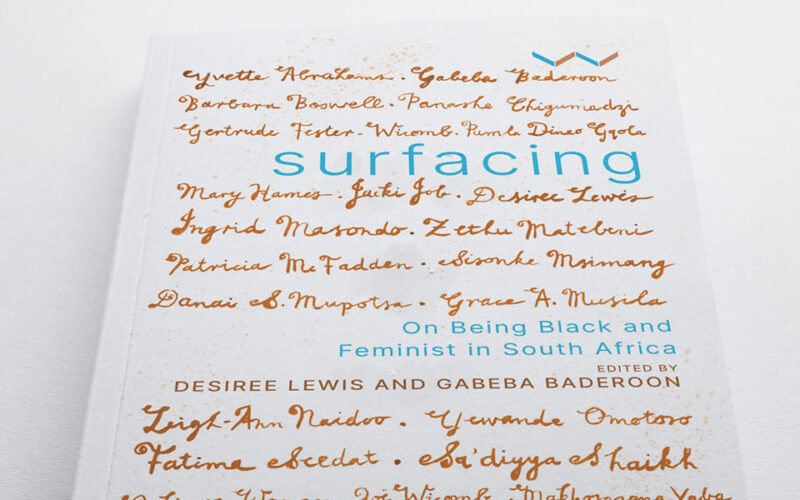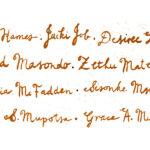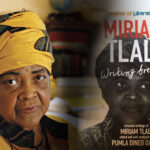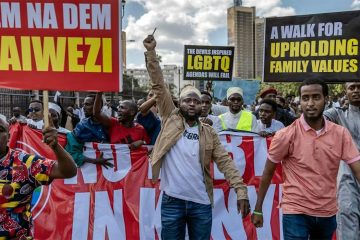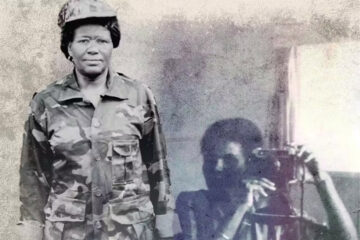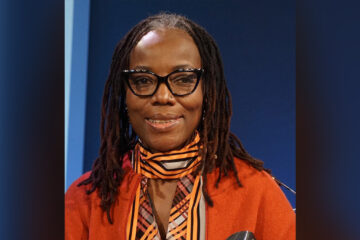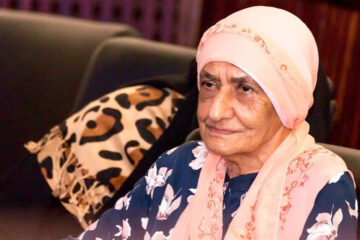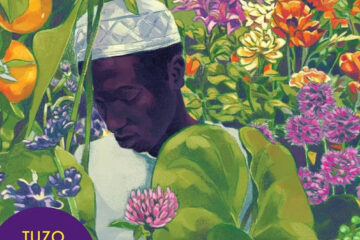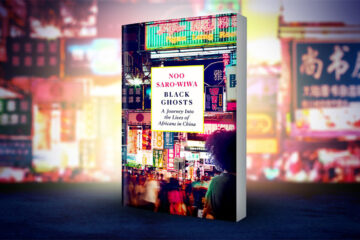SINDI-LEIGH MCBRIDE
SURFACING: On Being Black and Feminist in South Africa is a radiant presentation of the diversity of being a Black woman in South Africa. The book is aglow with the radical possibilities of art, activism and critical theory – easily illuminating diverse intellectual spaces, from divinity and dance to photography and philosophy. Ainhehi Edoro accurately described Surfacing as an “immersive experience” and “feminist utopia”, but it is also so much more than that – offering groundbreaking work.
The editors – feminist theorist Desiree Lewis of the University of the Western Cape and poet and feminist scholar Gabeba Baderoon, who is based at Penn State University in the United States – have not only curated contributions by some of the brightest luminaries, they have also shared a shining example of what Zoë Wicomb describes as “a mode of narration that none of us have dreamt of”. While Surfacing is a must-read for anyone interested in feminism and representations of Blackness, it is also a gift for anyone interested in interdisciplinary modes of knowledge production.
From the book’s first pages, Baderoon and Lewis establish that the collection of voices in it is not definitive, acknowledging the depth of Black feminist thought while still recognising the limitations of surveying the terrain. Instead, they have curated with care, asking questions about the nature of African feminist traditions outside the canon.
Following Stuart Hall, the book defines Blackness in terms of identification, “a dynamic recognition of oneself in the range of possibilities called blackness”, and the methodology for sourcing contributions was guided by an inclusive understanding of citizenship as participation.
As the question of who counts as South African has been troubled by exclusions, in Surfacing, they refuse ideas of residency and arrival and the simplistic route of legal citizenship. For Baderoon, “the collection conceives of belonging to a place as sharing in, bearing and contributing to its central debates”. Lewis explains this challenges “nationalist logics involving ‘essentialism and purity’ that have been so destructive to feminist thought” around the world.
Addressing erasure
They set the scene well, first mapping out Black feminism in the global imaginary then carefully but confidently they assert that Black South African feminisms have been subordinated to feminisms that are African American and what they term “continental” – feminisms from other African countries. One explanation for this is that “the meaning of blackness in South Africa is itself contested and fractured”; another is the ironic iconising of Black South African women such as Winnie Mandela and Sara Baartman. “They have been repeatedly invoked in North American-based black feminist artwork, scholarship and fiction,” they write, “yet few black southern African writers have achieved this status of universal visibility. It is as though Black South African women are worthy of being invoked as icons by other black feminists, but rarely – even within post-colonial feminist canons – granted positions of centrality as intellectuals themselves.”
In an interview by email, Baderoon explains that even while Black feminisms are recognised and valued in the Western academy, because of the enormous power wielded by the Western academy over intellectual work globally, “our students often cite African American theorists and, less often, Caribbean and West African scholars, but very rarely southern African ones. Our introduction argues that this neglect of southern African writers is a serious weakness of global conceptions of Black feminisms. Surfacing is an intervention in that erasure.”
Surfacing grapples with this strange and ambiguous visibility of southern African women in global Black feminisms, which Lewis points out is different from how white-centric feminism has historically dominated Black feminism – often by drowning out voices and speaking for others. In an interview, she explained that the domestic publishing and book marketing industries have played a large part in the neglect of South African feminism, but that “the global knowledge economy which – for historical and political reasons – celebrates ‘black’ knowledge and culture from certain geographical sites – often the US or West Africa – is largely to blame for the neglect of distinct feminist southern African histories, political struggles and knowledge-making traditions. The book draws attention to this by archiving a distinct legacy and flagging patterns of dominance within the globally marginalised body of black feminist thought.”
Unsettling the centre
Surfacing avoids the tedious, but common, assumption that feminist interventions are driven by desires to occupy, rather than to unsettle, the centre. Instead, the book focuses on how “those at the margins resolutely find critical creative, artistic or existential freedoms at the same time that they talk back to all forms of connected oppression”.
In this sense, the book mirrors OluTimehin Kukoyi’s recent definition of Black feminism.
“Black feminism is not about gaining and flexing power—it’s about finding freedom. It’s about securing the bodily autonomy, self-determination and wellbeing of all people, whether they fit into society’s restrictive ideals or not … It is committed to reducing harm and combating violence, especially against people who are disproportionately at risk. At its core, Black feminism is about radically loving people so that they can live well.”
Surfacing shows a lot of love, which is perhaps the core of its importance in terms of ways of knowing. Reading the essays, you get the sense that the highly personal, rigorously developed contributions were both developed and collated with a keen eye on the ethics of knowledge, a recognition of and respect for the ideas and work of women, at once reclaiming those who have been silenced, nurturing new voices and amplifying the validity of many ways of knowing.
The essays
In 2017, one of the contributors, Patricia McFadden, delivered a lecture at the University of Pretoria titled “African Thought Leadership:Writing as/for Resistance” in which she spoke about two features of writing: as process and as being. By breaking down the two terms, she offered what Nkule Mabaso describes as “a methodology towards writing as a revolutionary choice and revolutionary practice”. Each of the 20 essays in Surfacing employs this methodology, and each stands steadily on its own feet.
Sisonke Msimang’s contribution reflects on feminist biography through her experience of writing The Resurrection of Winnie Mandela. Msimang unpacks the loaded task of capturing Mandela’s gendered meaning – “to see her in representative and symbolic terms rather than in standard or even strictly biographical terms”. She talks to the deliberate decisions to write about her with intimacy, care and respect while still asking difficult questions about her tactics in navigating power in a context of war, and democracy.
Wicomb and Lewis then explore another hypervisible Black woman from South Africa: Sara Baartman. Their exchange deals critically with the 2018 controversy around the enrobing and disrobing of Willie Bester’s sculpture of Baartman in the main library of the University of Cape Town, exploring what it means to represent Baartman, “a ready-made cipher”.
The first part of the Unmaking section then begins with Pumla Dineo Gqola’s “playful but also very serious love letter to Gabrielle Goliath”, where she invites a sensory engagement with Goliath’s art. This is followed by Mary Hames’ reflection on how her history as a student during apartheid shaped her approach to teaching methodologies, and her goal of finding new ways to teach feminism, gender and identity, sex and sexuality. Related, gertrude fester-wicomb traces the lives of three prominent queer South Africans and the ways in which queer struggles under apartheid were embedded in lived intersectional experience, despite this only being theorised relatively recently.
jackï job, Fatima Seedat and Sa’diyya Shaikh also adopt an interdisciplinary approach in their exploration of divinity and religion. job moves from the shackles of having to “be a lady” according to chastening biblical narratives to the embodied freedom offered by dance. Muslim feminists Seedat and Shaikh deliberate on the gendering of divinity in interesting ways. Seedat observes a protest march in Cape Town and discusses the difficulty of reimagining the gender of divinity, a “blind spot in feminist consciousness”, while Shaikh traces anti-racist and feminist activism in a Muslim group as a counterpoint to the patriarchal weight of Islamic and secular education.
Zethu Matebeni’s memorial-style account in “Black Lesbian Feminist Thoughts of a Born Queer” is both a reading history of her rich discoveries in her aunt’s personal library, and an ode to familial love. Her harrowing description of being attacked and almost raped by a friend at university and the intense family support that helped her healing powerfully refutes the stereotype of family rejection of queer people.
Ingrid Masondo’s visual essay, “a tour of lesser-known black women’s photography as potent encodings of feminist ways of knowing” focuses on photography and relational platforms, using work by Keorapetse Mosimane, Thania Petersen and Tshepiso Mazibuko to show how “art speaks in ways that words don’t”.
Art and poetry
In the second section, Positioning, Yewande Omotoso extends the focus on art. She interrogates imagination in feminist struggles, citing responses to her characters and novels as both evidence of the complexities faced by Black women, fiction writers in particular, and motivation for employing imagination as “the act of making to unmake the ways of sensing and thinking that are often at the root of so much of what doesn’t work in our lives.”
Danai S Mupotsa’s “Breathing Under Water” is a poem cloaked as an essay, an autobiographical reflection thick with imagery and emotion, beautifully blurring the lines between forms and memories. There is, however, nothing blurry about Zukiswa Wanner’s “Do I Make You Uncomfortable? Writing, Editing and Publishing Black in a White Industry”, an incisive critique of bias and discrimination in the South African publishing industry and an inspiring account of her career and Black feminist practice.
In “Echoes of Miriam Tlali”, Barbara Boswell identifies Tlali as an early disruptor of masculinist Black Consciousness literary traditions in the 1970s, tracing how her “trajectory of fiction boldly confronted gendered identities and relations at a time when many urged importance of a unified black protest”. A similarly masterfully crafted narrative, Grace A Musila’s “My Two Husbands” is an engrossing read, revealing how she learnt “to navigate the unexpected consequences of educational achievements” from her grandparents, living and dead.
Also a reflection on engaging with elders, Panashe Chigumadzi calls attention to silences “heard” when speaking to women in her family about the many losses of Zimbabwean history, how she has learnt to discern their “militant” refusal to speak and in so doing, hear their silence. This chapter is especially poignant for quoting a conversation between Sindi van Zyl, a renowned Black woman doctor who recently, tragically, died. The conversation, shared on Twitter, is between Van Zyl and her 65-year-old Black woman patient, and the nuanced tact used when drawing out the women’s sexual history is a perfect illustration of how to hear silence.
The third part, Remaking, begins with Leigh-Ann Naidoo’s thrilling tale of a peace mission to Palestine, and the unexpected solidarities and complications thrown up by the unique situation of a transnational group of feminists adrift at the ocean who find themselves under attack from patriarchal imperialist forces. Just as thrilling is Makhosazana Xaba’s “The Music of My Orgasm”, especially her rivetingly matter-of-fact discussion of how forthright language from her mother about bodily pleasures through masturbation formed a foundation for her feminist thinking and practice.
Yvette Abrahams and Patricia McFadden conclude the section, both revealing freedom to be not simply a release from material and ideological subordination, but rather embedded in experiences with the Earth, the fruits of our labours and the “richly erotic, sensual and existential desires” of our multifaceted lived experiences.
Deepening perspectives
Writing in The Conversation, Baderoon and Lewis describe why these writings matter and how:“Foregrounding the positionality of the writer – the social and political contexts that shape their identities – can deepen what is being said. Who the author is and what perspective she speaks from are in fact integral to her view of the world.”
Lewis explains that “what is unusual is not the positionality (which all writing manifests) but the insistence on this, and the implication that this located knowledge is important – both among those who share certain locations and among those who don’t”.
They imagine Surfacing’s ideal audience to be “the kind of book everyone can keep by their bedside, but it is also a book for scholars, students and teachers too”, said Baderoon.
Surfacing can be appreciated for its beautiful writing, engrossing ideas and more importantly, the space it opens for Black feminist writers whose creative, philosophical and artistic work is often sidelined and trivialised, reduced only to “how this group testifies to oppression”. More than that, it is an intervention into the way that knowledge is produced, “how to think about ‘knowledge’ more completely and adventurously”.
And while the focus may be on South Africa, the book reveals the potential of these legacies to contribute to a global tradition of Black feminism. Intellectually, it is incandescent in how it imagines new ways of being that transcend racist and patriarchal world views. According to Baderoon, long after editing the chapters, Surfacing continues to enchant her as a reader, because “the inventive, brave and joyful conception of the world conveyed by the 20 writers points to a future that feels more pleasurable and hopeful as a result of being in their company”.

